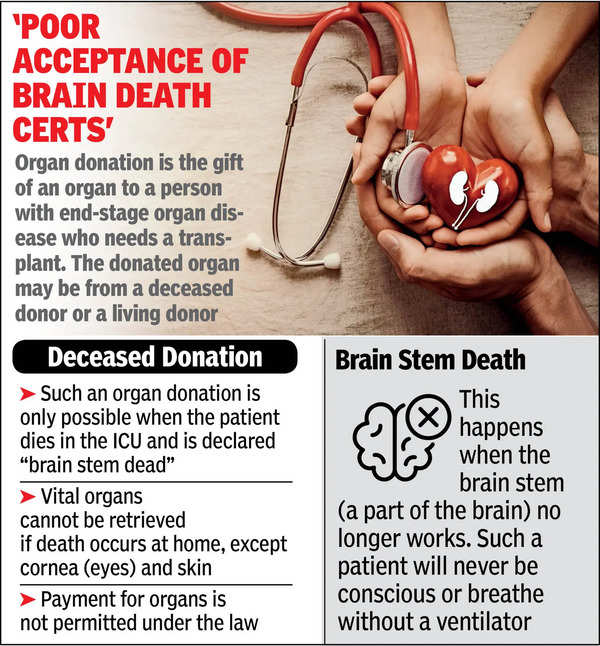Low cadaver donations in public hospitals compared to private hospitals in Mumbai | Mumbai News – Times of India


Mumbai: The mood in KEM Hospital, Parel, was one of euphoria on Friday afternoon. Cardiac surgeons who hadn’t slept a wink in 36 hours kept smiling as congratulatory messages kept pouring in; they had carried out a successful heart transplant, and the 38-year-old recipient seemed to be responding well. The patient’s 13-year-old daughter was so inspired that she wanted to become a cardiothoracic surgeon herself.
There was a dampener though.It had taken KEM, the city’s best known medical college that counts the county’s first heart and kidney transplants among its achievements, 56 years to repeat a heart transplant. The previous two heart transplants conducted at KEM Hospital were India’s first and second heart transplants—performed by Dr Prafulla Kumar Sen about three months after South African surgeon Dr Christiaan Barnard performed the world’s first heart transplant on Dec 3, 1967.

Why had it taken KEM over half a century to conduct its third heart transplant? In fact, why does every public hospital in the city lag behind private hospitals in the transplant field?
A telling stat is the number of brain-dead donors in the city’s public hospitals: 36 in the last 27 years since the first brain-dead donation under the Transplantation of Human Organs Act (1994) in the city. In contrast, the private sector has 680 deceased donations in the same period.
Deceased donations (see box) are like the first step in an organ transplantation programme of a hospital; one donor can save seven patients suffering from different end-stage organ failures. A closer look at the donation figures in public hospitals shows a dismal scorecard: Sion Hospital (where the first cadaver kidney transplant under the TOHA Act took place in 1997) has had 15 deceased donations in 27 years. KEM is second with 12 deceased donations, followed by state-run JJ Hospital (4), civic-run Nair Hospital (2), Navy’s INHS Asvini (2) and Railway Hospital (1).
Experts said the reasons range from overworked public hospitals, crippling number of vacancies, the lack of trained staff to apathy and poor acceptance of brain death certification.
Dr Vatsala Trivedi, who performed Sion Hospital’s first cadaver kidney transplant, blames the apathy in medical colleges which see many trauma patients. Trauma or road accident victims face a higher risk of brain death, and are potential organ donors. But over-burdened public hospitals rarely report brain-death. “One won’t see head injury patients in corporate hospitals as they would be brought to public hospitals,” she said.
Dr Trivedi said heads of many public hospitals are themselves not interested in brain stem death identification or certification, a long process involving four doctors.
Dr S K Mathur of the Zonal Transplant Coordination Centre-Mumbai traced the problem to the absence of dedicated transplant teams in public hospitals. “There is infrastructure, but not adequate trained staff,” he said. Some hospitals don’t have transplant coordinators though the centre has made the post mandatory and provides Rs 35,000 as pay, Dr Mathur added.
Dr Sunil Shroff of NGO Mohan Foundation, which works with hospitals across the country to raise awareness about deceased donations, said public hospitals in Tamil Nadu and Gujarat are active with cadaver donations. “It makes a difference when there is political will or interest from the highest level in the hospital or state,” he said.
Dr Shroff gave the example of Nagpur that has seen a huge rise in donations after the local ZTCC, counsellors from Mohan Foundation and NGO Help the Poor tied up to counsel families of brain-dead patients. “Nagpur’s govt colleges are active in deceased donations too,” he said.
BMC’s additional municipal commissioner Dr Sudhakar Shinde said he has decided to make transplant his focus after he noticed long gaps in liver and heart transplants in KEM Hospitals. He said he held 40 meetings in the last nine months with KEM’s doctors to push for the heart transplant conducted on Friday.















